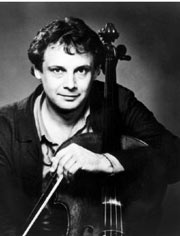PIETER WISPELWEY
Benaroya Recital Hall, Third and Union, 325-7066, $18-$27 3 p.m. Sun., April 21
BACH’S SIX SUITES for solo cello have represented the supreme test of a cellist’s interpretive powers ever since Pablo Casals rediscovered them and brought them into the standard cello repertory in the 1930s. Since Casals’ time, nearly every major cellist has recorded them (Yo-Yo Ma made a series of music videos around the Suites), and they’ve even been transcribed for many other instruments—viola, double bass, harpsichord, recorder, and trombone, to name a few—testimony to the Suites’ beauty and depth.
The Suites are far from easy, but Bach wrote them with an intimate understanding of cello playing—what’s awkward and what’s not for the instrument, what “lies well” under a cellist’s hands. So the primary challenge is not technical, it’s interpretive: What do you do with them? Baroque music in general tended to be bare bones in its notation—composers didn’t take the time to write down detailed performance instructions that the musicians of their time could be assumed to know. But the surviving manuscripts of the Suites are sketchier than usual—even basics like tempo, dynamics, and bowing go unspecified.
This Sunday afternoon’s performance by Dutch cellist Pieter Wispelwey will be the fourth Bach cello concert in Seattle in less than two months. Lynn Harrell played the Third Suite during his March 5 Benaroya Hall recital. His quick tempos and playful exploration of countless varieties of soft dynamics were a daring approach for Benaroya’s 2,600-seat main auditorium and gave much of the music a sort of caressing sparkle. The Seattle Cello Society’s annual Bach Marathon on March 9 featured 23 cellists tag-teaming the 36 movements, covering the gamut of style from Rich Eckert’s chaste clarity to the scampering whirlwind conjured by Rajan Krishnaswami.
And on February 25, Matt Haimovitz played three of the Suites to a standing-room-only crowd of 230 at Ballard’s Tractor Tavern (Haimovitz is touring the country with the Suites, playing in unconventional but appropriately intimate venues like the Tractor). His approach, which can be heard on his three-disc recording released on his own Oxingale label, is to turn the Suites into dramatic soliloquies, and he applies to them a huge range of color, dynamic nuance, and especially rubato—moment-to-moment tempo fluctuation. Compelling as the results are, Haimovitz takes the Suites far from their dance roots (there was very little toe-tapping at the Tractor that night). What’s lost in his approach is the cumulative energy that a steadier tempo and a more straightforward approach can produce.
All baroque suites are collections of stylized dance movements, with their origins in the ballet and in folk dance. The most common layout is the one that all six of Bach’s cello Suites follow—there are six movements in each, a prelude followed by five dances: allemande, courante, saraband, gigue, plus an “alternative” dance (a minuet, bourr饬 or gavotte), lighter and more tuneful, placed in the penultimate position just before the gigue.
In his recording (Channel Classics 12298), Wispelwey’s chosen to emphasize a distinctive mood or color for each Suite. The First, lighter and relatively uncomplicated, becomes an inward reverie, to contrast with the emotional projection of his actorly approach to the Second; for example, the Second Suite’s sarabande, in Wispelwey’s hands, turns even darker than usual, brooding and glowering. His performance of the Third Suite is triumphant, stately, full of gravitas. He finds some fantastical moments in the Fourth—a dreamlike, otherworldly serenity in the sarabande or gritty jolts of electricity in the scudding 16th-note runs in the courante. The Fifth Suite is ceremonial, even a bit pompous.
Wispelwey plays the Sixth Suite on the instrument it was written for, a very rare five-string cello (unlike most cellists, who valiantly relish the extreme difficulties that arise when the Suite’s played on a standard four-stringer). Even listeners accustomed to string timbres will be astonished hearing a cello equipped with a top E string—it’s like nothing any other string instrument has to offer, a vivid silvery sheen that sounds very different from a violin or viola playing in the same register.
Wispelwey’s concert should provide an excellent demonstration of the versatility of these Suites and the perennial fascination they hold for musicians and listeners. Wispelwey’s also been acclaimed as a specialist in contemporary music—a logical combination, since, like new music, Bach’s Suites offer the cellist the opportunity to be an explorer and come up with his or her own interpretive answers without relying on received tradition.







